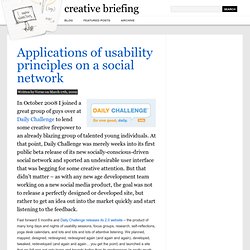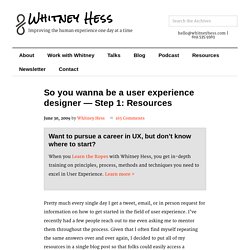

Applications of usability principles on a social network. In October 2008 I joined a great group of guys over at Daily Challenge to lend some creative firepower to an already blazing group of talented young individuals.

At that point, Daily Challenge was merely weeks into its first public beta release of its new socially-conscious-driven social network and sported an undesirable user interface that was begging for some creative attention. But that didn’t matter – as with any new age development team working on a new social media product, the goal was not to release a perfectly designed or developed site, but rather to get an idea out into the market quickly and start listening to the feedback. Fast forward 5 months and Daily Challenge releases its 2.0 website – the product of many long days and nights of usability sessions, focus groups, research, self-reflections, yoga desk calendars, and lots and lots and lots of attentive listening.
And that’s what this post is about (in case you were wondering where I was going with all of this…). 1. 2. 3. So you wanna be a user experience designer — Step 1: Resources. Want to pursue a career in UX, but don’t know where to start?

When you Learn the Ropes with Whitney Hess, you get in-depth training on principles, process, methods and techniques you need to excel in User Experience. Learn more > Pretty much every single day I get a tweet, email, or in person request for information on how to get started in the field of user experience. I’ve recently had a few people reach out to me even asking me to mentor them throughout the process. Given that I often find myself repeating the same answers over and over again, I decided to put all of my resources in a single blog post so that folks could easily access a consolidated version of my advice. So you wanna be a user experience designer? The best way to learn a new language is to go to a country where it’s spoken and immerse yourself in the confusion. If you’re interested in getting to know more about user experience, I recommend doing the same. …as well as any other topics that come up along the way.
UX Books. Interface Element Blog. When I was a teenager, I always felt like my design heroes had some kind of special sixth sense.

I had done my homework—they had no special training or education, yet they sized and placed elements in their interfaces in a way that seemed to make perfect sense. I practiced tirelessly, designing and re-designing Photoshop-based websites late into the night. My visual style improved with every iteration, but the actual interfaces remained so-so. For all my practice, intuition could only carry me so far. It wasn’t until college that I started reading more design books and realized that I wasn’t asking the right questions during my process. Why is the user on this screen? It was no longer about patterns and standards and all about how those can facilitate the user’s experience. I’m going to demonstrate how those questions impact my design thinking with a walkthrough of a design I’m working on now. Identify the primary goal Before I do anything, I have to get into the user’s head.